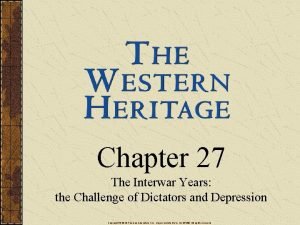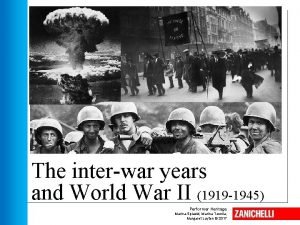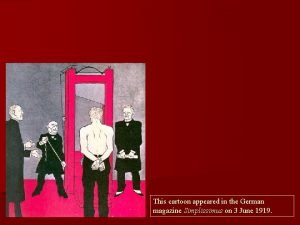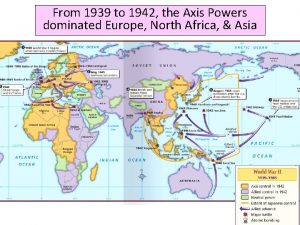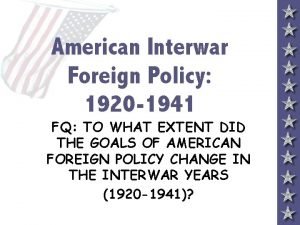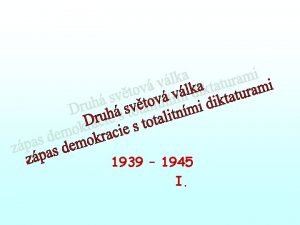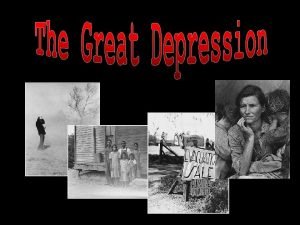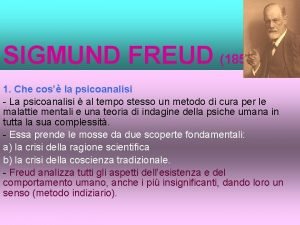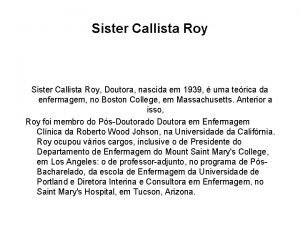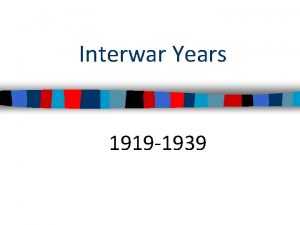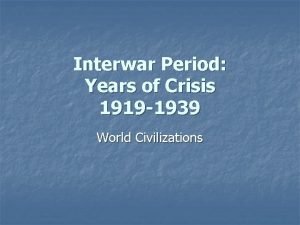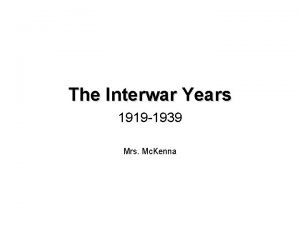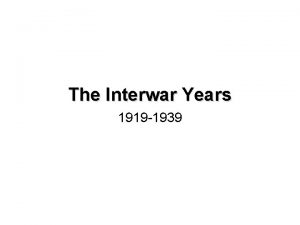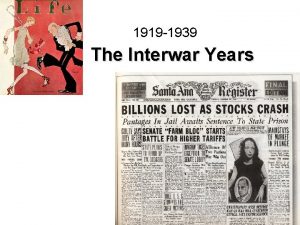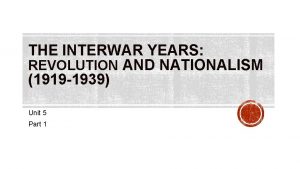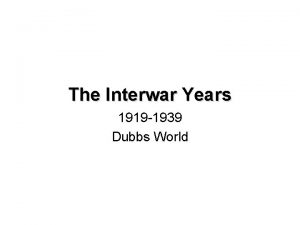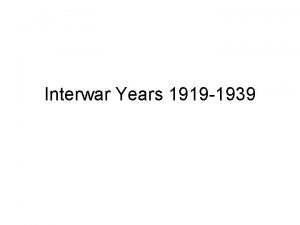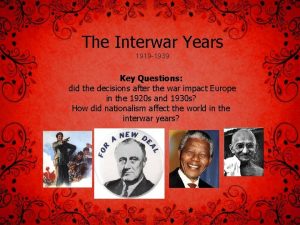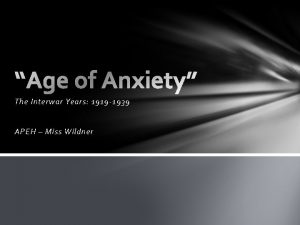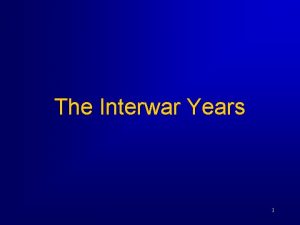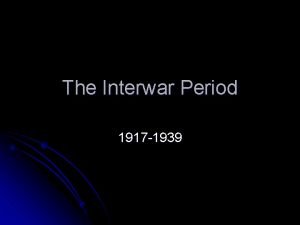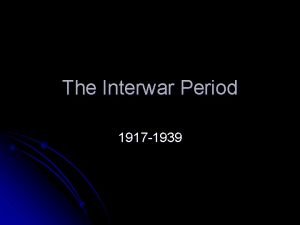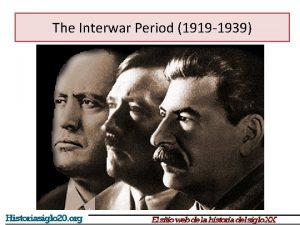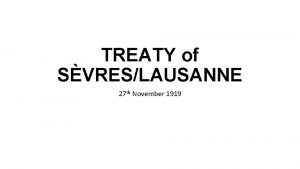The Interwar Years Europe 1919 1939 Treaty of




















- Slides: 20

The Interwar Years Europe 1919 -1939

Treaty of Versailles Review ► To Germans of all political parties, the Versailles Treaty represented a harsh, dictated peace, to be revised or repudiated as soon as possible. ► ► ► East Prussia was separated from the rest of Germany by the “Polish Corridor” that extended north to the Baltic Sea. ► ► Article 231 placed sole blame of the war on Germany required to pay enormous reparations to Britain and France Germany’s military strength severely weakened Germany lost Alsace & Lorraine to France Germany lost eastern territory to Poland French troops would occupy territory west of the Rhine River and a small strip of land east of the Rhine to ensure against German aggression. These territories were to be permanently demilitarized

Con’t: ► France took economic control of the Saar border region which was rich in coal and iron mines The region would be administered for 15 years by the League of Nations ► After 15 years, the people of the Saar could vote on whether to remain part of Germany or become part of France. ► France was eager to punish Germany (but even more eager to ensure its future security against German aggression) ► While Britain also sought to punish Germany, many Brits believed a healthy German economy was essential to a healthy British economy. ► John Maynard Keynes (most significant economist of 20 th century) criticized Versailles Treaty, declaring its punishing of Germany would damage the European economy. See p 871) ► Economic Consequences of the Peace, 1919 ►

Democracies in the 1920 s ► ► Fear of Communism In 1919 fear of Bolshevism swept through Europe (also known as "Red Scare") Civil war in Russia raged as the Bolsheviks were defeating their numerically superior “White” opponents Communist revolutionaries took over Berlin for a week in January, 1919

Germany: Weimar Republic ► § The Social Democratic Party (S. P. D. ) took control of the government on November 9, 1918 ► ► ► Kaiser Wilhelm II abdicated that same evening The S. P. D. had been the largest party in Germany prior to the war Fear of communist revolutions throughout the country prompted Philip Scheidemann to proclaim a republic, but without official consent from any other parties.

The Weimar Gov’t in June 1919 signed the Versailles Treaty probably dooming the Weimar Republic from the start ► Conservatives, including influential military elements, saw the signing of the treaty as a “stab in the back” or the “diktat”— the “dictated peace” ►

► Threats from the Left § Germany’s lack of experience with democratic traditions made the Weimar’s hold on power tenuous § The Weimar Republic had to rely on conservative military groups to save it from communist outbreaks throughout the country § This hurt the republic’s prestige § The gov’t was given support by the military provided that the gov’t maintain discipline in the army and root out Bolshevism § In effect, the Weimar gov’t became a prisoner of the German army

► Political Instability: “Freikorps” (Free Corps), right-wing paramilitary groups that formed after the war, became the vanguard of anti-communist repression ► Spartacists, a group of communists led by Rosa Luxemburg and Karl Liebknecht, took control of Berlin for a week in January 1919. ► Elements of the “Freikorps” crushed the communist uprising, killing its leaders ► Elections in January created a center-left coalition in charge of running the government ► § S. P. D. had the most seats in the Reichstag but also shared power with the Center Party and the German Democratic Party. § The capital was moved to Weimar to distance the gov’t from the Prussian imperial traditions of Berlin

§ New Constitution created in August 1919 ► ► Reichsrat: upper chamber represented the Federal states. Reichstag: lower house elected by universal suffrage; supplied the Chancellor and Cabinet. President elected for a 7 -year term. Female suffrage granted

Threats from the Right ► Kapp Putsch, 1920 ► ► Conservative politicians and businessmen, with help from disgruntled army officers, took control of Berlin in March and declared a new government Conservative parties gave their support At the same time, right-wing conservatives took control of Bavaria ► Chancellor Ebert implored workers to defend the Weimar Republic ► A general strike resulted which brought the country’s economic activities to a halt ► The putsch collapsed as a result and the republic was saved ► Though certain conservative groups failed to take power forcefully, they continued to gain seats in the Reichstag ► The S. P. D. eventually withdrew from the government leaving a fragile center-right coalition in charge. ►

Ruhr Crisis, 1923 ► Reparations: As provided for in the Versailles Treaty, the Allies announced in 1921 that Germany had to pay almost $34 billion in reparations Germany's economy was still weak and it could not pay all of the reparations. ► 1923, France, led by Raymond Poincaré, occupied the industrial Ruhr region of Germany. ► In response, the Weimar gov’t ordered Ruhr residents to stop working & passively resist French occupation. ►

Economic Mess: Hyperinflation+Reparations Runaway inflation occurred when Germany printed money to pay reparations ► The value of the German mark went from approximately 9 marks per U. S. dollar in 1919 to 4. 2 trillion marks per dollar by mid -November 1923! ► Brought about a social revolution in Germany: Accumulated savings of many retired and middle -class people were wiped out ► Middle-class resented the gov't and blamed Western gov't, big business, workers, Jews, and communists for nation's woes. ►

Beer Hall Putsch, 1923 Adolf Hitler and the Nazi Party failed to overthrow the state of Bavaria and Hitler was sentenced to one year in jail (where he wrote Mein Kampf. ) ► Hitler’s light jail term reflected conservative judges who sympathized with antirepublican views. ►

Germany rejoined the world community of nations ► Gustav Stresemann assumed leadership in 1923 § § § ► Called off passive resistance in Ruhr and agreed to pay reparations (but also sought consideration of Germany's ability to pay) Poincaré agreed Supported by Social Democrats Dawes Plan, 1924: League of Nations plan that restructured Germany's debt with U. S. loans to Germany to pay back Britain and France, who likewise paid back the U. S. Resulted in German economic recovery ► Young Plan (1929): continuation of Dawes Plan (moot when Great Depression hit) ►

Hopes for a peaceful future: Locarno Pact, 1925: Germany and other European nations agreed to settle all disagreements peacefully. ("spirit of Locarno" = peace) ► Germany allowed to join League of Nations in 1926 ► In return, Germany had to guarantee western borders with France and Belgium ► Disagreement over Germany’s eastern border with Poland remained unresolved ► ► Kellogg-Briand Pact, 1928: Renounced war as "illegal" except for self-defense; signed by 62 nations but had no real enforcement mechanism

France: economic problems ► ► ► Challenges were similar to those in Germany Death, devastation, and debt of WWI created economic chaos and political unrest (see chart in text) Throughout the 1920 s, the government’s multi-party system was dominated by parties on the right (conservatives) ► ► ► Supported status quo and had backing of business, army, and Church. 1926, Raymond Poincaré was recalled to office Gov’t slashed spending and raised taxes, restoring confidence in the economy.

Great Britain Wartime trend toward greater social equality continued, helping maintain social harmony. ► Representation of the Peoples Act (1928): women over 21 gained the right to vote. (Representation of Peoples Act of 1918 had given women over 30 the right to vote). ► Yet, the concentration of wealth in Britain was more geared towards the top than any other European country ► § Top 1% owned 2/3 of the national wealth

Growth of social welfare ► After WWI, the gov’t provided unemployment benefits of equal size to the unemployed and supplemented those payments with subsidized housing (200, 000 units), medical aid, and increased old-age pensions. ► Labour party rose as a champion of the working classes and of greater social equality and took power briefly in 1924 (9 months) ► Led by Ramsay Mac. Donald ► Labour Party came to replace the Liberal Party as main opposition to conservatives. ► Liberal party’s traditional 19 th century support of free trade no longer seemed as relevant ►

The Irish “Question” ► ► After Easter Rebellion (1916) the extremist Sinn Fein faction gained prominence in Ireland. Prompted a civil war between the Irish Republican Army (IRA) and the Black and Tan, England’s special occupation forces there. October 1921, London created the Irish Free State, from which Ulster withdrew, as part of the British Commonwealth (Northern Ireland) In 1922, Britain granted southern, Catholic Ireland full autonomy after failing to suppress a bitter guerrilla war. § IRA organized and led by Michael Collins

► ► ► Loosening of the empire End of its protectorate in Egypt (except Suez Canal) Equality of British Dominions – Canada and Australia
 Chapter 27 the interwar years
Chapter 27 the interwar years The interwar years unit test
The interwar years unit test The interwar years zanichelli
The interwar years zanichelli Treaty of versailles guillotine cartoon
Treaty of versailles guillotine cartoon Who dominated europe, north africa and asia from 1939-1942?
Who dominated europe, north africa and asia from 1939-1942? Interwar america
Interwar america Interwar period timeline
Interwar period timeline Interwar foreign policy
Interwar foreign policy Goat years to human years
Goat years to human years 300 solar years to lunar years
300 solar years to lunar years How long is “four score and seven years”?
How long is “four score and seven years”? Varför kallas perioden 1918-1939 för mellankrigstiden?
Varför kallas perioden 1918-1939 för mellankrigstiden? Stagecoach 1939 cast
Stagecoach 1939 cast Poland population 1939
Poland population 1939 White e lippitt (1939)
White e lippitt (1939) Henri matisse la musique 1939
Henri matisse la musique 1939 1939 market crash
1939 market crash Mapa de alianzas de la segunda guerra mundial
Mapa de alianzas de la segunda guerra mundial Dubai population pyramid
Dubai population pyramid Freud uuu
Freud uuu Biographie de callista roy
Biographie de callista roy
